Text
Way of the Four Elements yet again
Previous attempts wound up being a little ridiculous, so I started from scratch by looking at EK and AT. This is more inline with them, but still features a neat capstone that plays with monk as a spellcaster.
Spellcasting (Wis)
Druid spell list, following 1/3rd caster rules
Evocation/Transmutation
3: Elemental Fist
As a bonus action, expend a spell slot to imbue your unarmed attacks with elemental energy. When you use this ability, choose Acid, Cold, Fire, Lightning, or Thunder. Until the end of your turn, your unarmed attacks deal an additional amount of energy damage of the chosen type equal to 1d6 per level of the spell slot expended.
6: Elemental Synergy
After casting a cantrip as an action on your turn, you may use Flurry of Blows as if you had used the Attack action instead.
11: Elemental Synthesis
As a bonus action on your turn, you can convert a spell slot into ki or vice versa, up to the normal maximum of each. Each spell level of the slot expended restores 1 ki. However, spell slots require two ki per level of the slot regained.
17: Elemental Flurry
When using a Flurry of Blows, each attack can be substituted for a cantrip that requires one action or bonus action to use.
0 notes
Text
Monk Subclasses
Way of the Aegis
3: Shield Arts - You gain proficiency with shields, and may use one without losing access to unarmored defense or unarmored speed. You may make attacks with it as a melee monk weapon that deals blunt damage, and do not lose its bonus to AC when doing so.
6: Deflect weapons - When using a shield, you may use your reaction to deflect a single melee weapon attack that hits you, using the rules for deflect arrow. If the damage is reduced to zero, you may spend one ki point to redirect the attack back at the attacker or at any target with five feet of both of you, again using the rules for deflect arrow to determine success and damage.
6: Outer Shell - When attacking with a shield, it is considered a magic weapon for determining resistances.
11: Interposition - If you have used patient defense and are using a shield, you can use your reaction to interject yourself between an attacker and their target, if that target is within 5' of you. You become the new target of that attack.
11: Vigilant Guardian - You no longer need to spend ki to use patient defense as a bonus action.
17: Phalanx of One - Your mastery of the shield is so complete, that you have resistance to bludgeoning, piercing, and slashing damage, until the beginning of your next turn whenever you are wearing a shield and use Patient Defense.
Way of the Four Elements (yet again)
3: Spellcasting (Wis) - uses the druid spell list. 1/3rd caster, as per Eldritch Knight or Arcane Trickster. Preferred schools are Evocation and Transmutation.
3: Fist of Unbroken Air - When spending ki to use Flurry of Blows, your unarmed attacks gain a range of 30'. They are still considered melee attacks.
6: Winding River - When spending ki to use Step of the Wind, you gain the benefits of both the disengage and dash actions.
Elemental Synergy - After casting a cantrip as an action on your turn, you may use Flurry of Blows as if you had used the Attack action instead.
11: Patience of Stone - When spending ki to use Patient Defense, you gain 10 temporary hit points that last until the start of your next turn.
17: Rebirth in Flames - When your hit points reach zero, you can expend all of your remaining ki to stay upright and return to one hit point. For each point of ki you had, one creature within ten feet of you can be healed for 1d6 hit points or suffer 1d8 fire damage. Individual creatures can benefit or suffer from this effect multiple times, up to the number of ki points expended.
5 notes
·
View notes
Text
Yes but now there's a million of the fuckers and none of them pay rent
ocs are great you just make up a guy and do whatever you want with them and it's free and nobody can stop you
45K notes
·
View notes
Photo

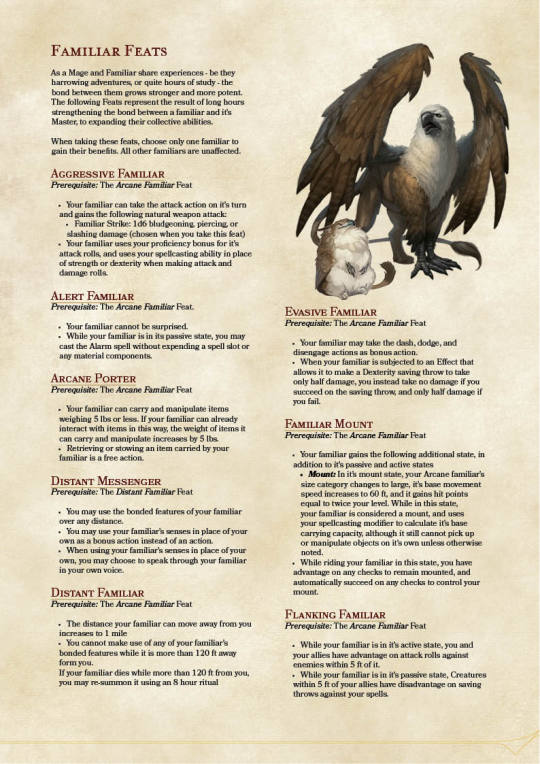
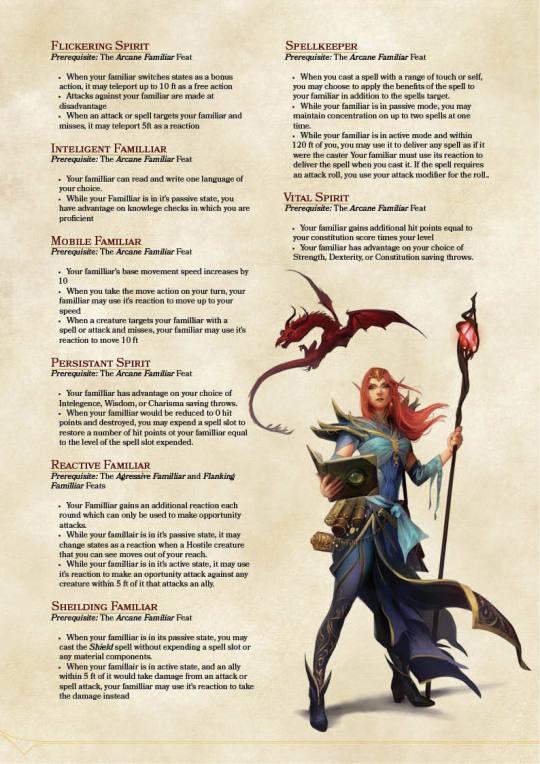


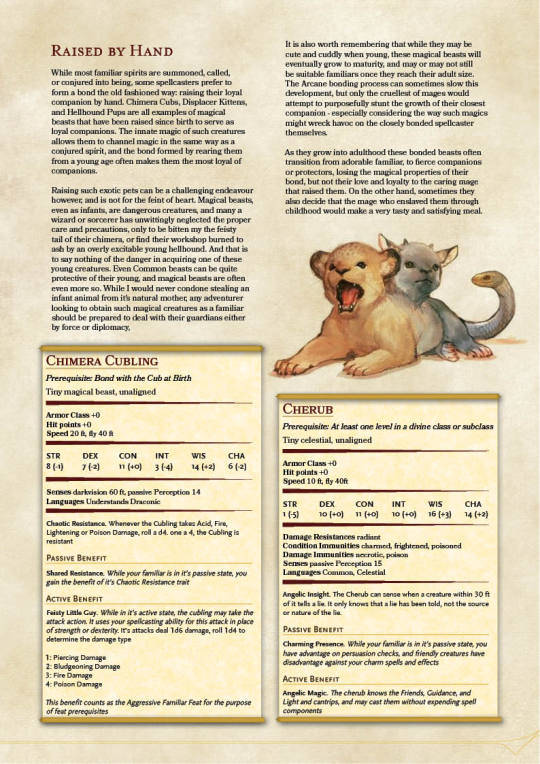
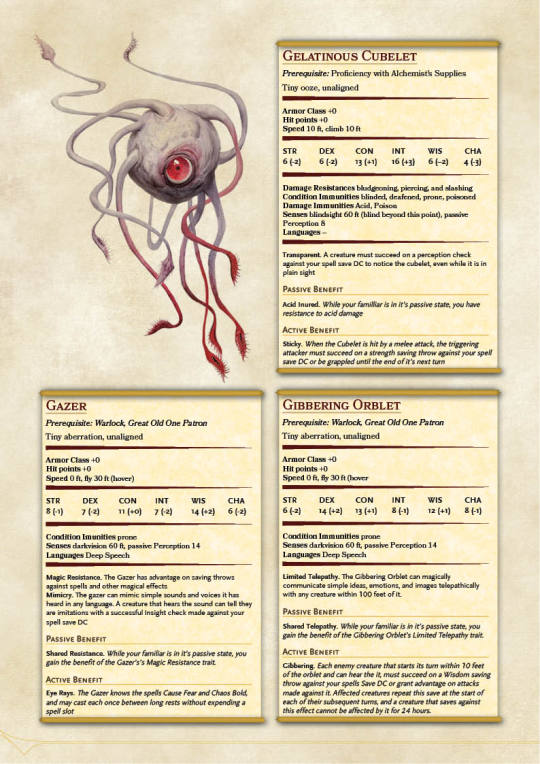
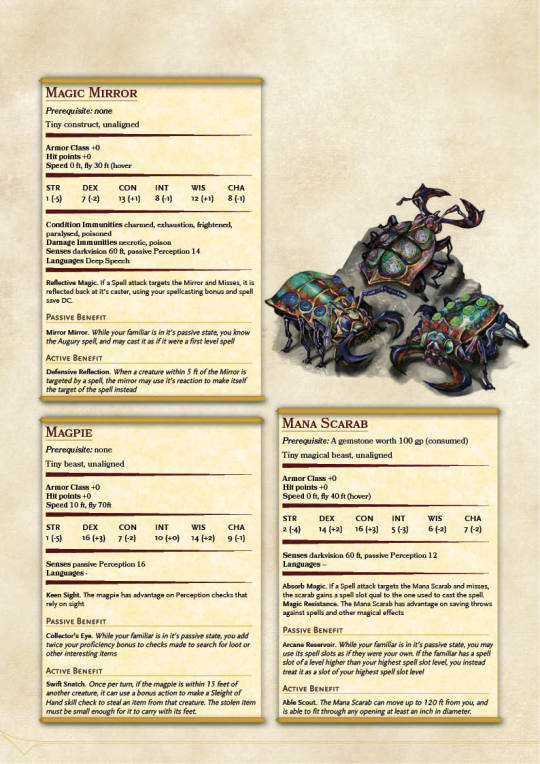
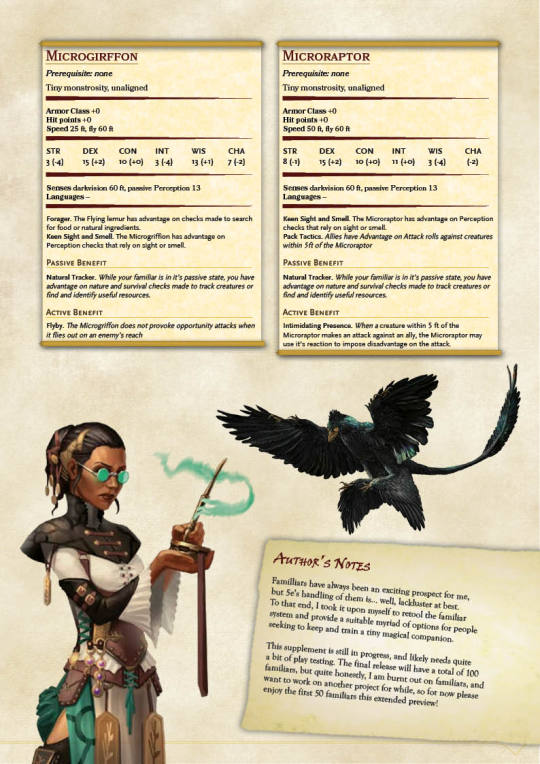
Time for a trip to the magic pet store: Here is a preview of what will be
Clockwork Dragon’s Guide to Arcane Familiars
Familiars have always been an exciting prospect for me, but 5e’s handling of them is… well, lackluster at best. To that end, I took it upon myself to retool the familiar system and provide a suitable myriad of options for people seeking to keep and train a tiny magical companion.This supplement is still in progress, and likely needs quite a bit of play testing. The final release will have a total of 100 familiars, but quite honestly, I am burnt out on familiars, and want to work on another project for while, so for now please enjoy 13 new Feats, and the first 50 familiars in this extended preview.
As a major notice on this bit of brew: the guide to familiars is still a work in progress, and I’m still in the process not only of adding new familiars, but also sourcing all of the artwork. I don’t do any of my own art, and I always try to credit that artwork back to the original creator. The final published release of this document will contain citations and sourcing for all artwork, but as ths is only meant to be a WIP preview so you all know what I have been working on, much of that is still missing, and will be updated as I work through it.
Preview images above are low resolution, and does not contain all 50 familiars. For the latest high-resolution PDF, as well as a whole host of other work I have done, check out this handy dropbox link. And be sure to tell me what you think!
If you like what I do and want to support me or just generally help out, Check out my Patreon page, or throw some coin at me through Paypal.me. If you wanna just come say hi on my Discord, that’s great too!
7K notes
·
View notes
Text
Tonberries
I love these little guys. I tried to evoke their lore from the games, but still make them a playable race. Relentless is the ability I’m least sure of. I wasn’t sure whether to cap it at 5 days, thus maxing exhaustion at 5 points, or letting players keep going past that, knowing it will kill them. I can see some potential for abuse with short-rest based builds (coughwarlockcough), though.
Ability Scores: Your Constitution score increases by 2, and your Dexterity score increases by 1.
Age: Tonberries typically reach maturity at the age of 60, and typically live around 800 years. While they are long-lived, they have an extremely low birth rate, due to both natural proclivities and low fertility.
Size: Your size is Small.
Speed: Your base walking speed is 20 feet.
Rancor’s Flame: Any candle, torch, lantern, or similar item you hold can be ignited as a bonus action on your turn, without a source of fire. Any object lit in this way requires no fuel. When using this ability, you can choose to have the object shed only dim light to its maximum radius.
Candlelit: Dim light does not impose disadvantage on your Wisdom (Perception) checks that rely on sight.
Relentless: When taking a short rest, you can choose to forgo your long rest for the day without accumulating exhaustion. You do not gain the benefits of a long rest when doing so. After your next long rest, you gain one point of exhaustion for each day you did not take a long rest.
Knife in the Dark: You have proficiency in the Stealth skill and cook’s utensils.
The legend of the tonberries is one of blood and terror. Even their own legends say they were created by a vengeful goddess to be her instruments of restitution. Every tonberry carries a piece of that goddess’ hatred within them, which they call Rancor, and it lights their way in dark places.
In the modern era, the goddess has been all but forgotten save by a handful of radical devotees. She is remembered only as the Bladed Mother, and while few worship her, many tonberries carry a knife at all times, in honor of her.
In the wider world, tonberries have a whispered reputation as silent, implacable, unstoppable killers. To have a tonberry after you is to be already dead. In truth, most of that reputation stems from a single, prolific assassin whose career spanned centuries, using the natural tools of the tonberries to vicious effect.
Tonberries favor solitude and exploration, especially of ancient ruins and forgotten caverns. They occasionally will live together in small clusters, usually for protection when other beings settle near them, but without continued pressure to stay together, will frequently drift apart.
The few tonberries who form bonds outside of their own people often find them less chafing, and can make very supportive neighbors or adventuring companions. Those who make the effort find most tonberries to be exceptional chefs… as long as they clean their knives beforehand.
2 notes
·
View notes
Photo

Table of Contents
Part One: A Note To Get Started Part Two: Manifestation :: Source Part Three: Manifestation :: Performance Part Four: Transformative Magic Part Five: Manifestation :: Permanent Reminders Part Six: Manifestation :: Temporary Reminders Part Seven: Catalyzing Spells Part Eight: Magic in Writing Part Nine: Cultural Magic Part Ten: World Integration Part Eleven: Using Real-World Elements Part Twelve: A Questionnaire For Building Magic Systems Part Thirteen: Practitioner Tropes :: Eyes Wide Open Part Fourteen: Practitioner Tropes :: Witches and Wizards Part Fifteen: Practitioner Tropes :: Sorcerer and Warlock Part Sixteen: Practitioner Tropes :: Shaman Part Seventeen: Practitioner Tropes :: Druids Part Eighteen: Practitioner Tropes :: Witch Doctors Part Nineteen: Practitioner Tropes :: Magical Girls Part Twenty: Practitioner Tropes :: Necromancers Part Twenty-One: Practitioner Tropes :: Conjurers & Summoners Part Twenty-Two: Practitioner Tropes :: Seers, Oracles, & Visionaries
(Note from Pear: This series is indefinitely open to new posts. As they are added, this post will be updated. Like always, you can find original content in the posts by pear tag and the table of contents tag for series.)
2K notes
·
View notes
Text
Dragoon (Fighter archetype)
Goodness knows we all love the stupid leaping plate mail spear guys from Final Fantasy, and we’ve all been trying to make one work in D&D for as long as we’ve known about both things. Here’s my latest attempt.
Battle Leap: At 3rd level, as a bonus action on your turn, you can become Jump Ready. You ignore all falling damage and are always considered to have a running start when making a long or high jump. In addition, your maximum long jump distance is equal to your movement speed, and your maximum high jump distance is equal to half your movement speed. You gain advantage on all Athletics and Acrobatics checks to clear obstacles and land safely. Jump Ready lasts until the beginning of your next turn. --At 10th level, your maximum high jump distance is equal to your movement speed, and your maximum long jump distance is equal to twice your movement speed, taking up movement at half the normal rate.
Jump: At 7th level, as an action on your turn while you are Jump Ready, you can make a single attack against a target within your movement range (using movement as normal for a long jump) and return to your starting position without using additional movement. This attack requires line of affect to the target, but does not provoke opportunity attacks.
High Jump: At 10th level and while Jump Ready, as an action that ends your turn, you can leap gracefully into the air up to your maximum high jump distance, remaining there until the beginning of your next turn. You must resolve High Jump at the beginning of your next turn, and Jump Ready remains in effect until you have done so. As an action, you land on a target within a distance equal to the height of your High Jump (e.g. if you jumped 20' up, your range for this is 20') and attack. If this attack is successful, you automatically deal critical damage. You land next to your target, or begin to fall if your target is midair.
Chain Jump: At 15th level, after a successful Jump attack, you may Jump to another target and make an additional attack, up to the maximum number of attacks you can make in an attack action. Each target may only be attacked once during this action. You may only travel as far as your long jump distance allows, cumulative between targets, and you return to your starting position as normal. There must be line of affect between all targets and your starting position.
Dragon Knight: At 18th level, you are always considered to be Jump Ready, and no longer have to use a bonus action to become so. After a successful Jump or High Jump attack, you may use a bonus action to make an additional attack with the same weapon. Your maximum high jump distance is equal to twice your movement speed, and your maximum long jump distance is equal to four times your movement speed, taking up movement at a quarter the normal rate.
High Jump is kind of confusing, so here's an example.
Ghole (Lv10 dragoon) and Nafiya (Lv10 paladin) are fighting an ogre in its cavern lair (maximum clearance approximately 25 feet). Nafiya has been keeping the ogre at bay with her shield while Ghole makes Jump attacks from a distance, but Nafiya is beginning to look battered. They had discussed a tactic beforehand, and try to implement it now.
On his turn, Ghole uses a bonus action to become Jump Ready, moves to within 20' of the ogre, and executes a High Jump, ending his turn. The ogre is next. Realizing something strange is going on, it swipes at Nafiya, which she barely deflects with her shield, then backs away -- but Nafiya has Sentinel. Here, the scenario will split into two.
In scenario one, the Sentinel attack misses, and the ogre backs up a further 20' (total of 40' away from Ghole). Nafiya holds her ground, using her action to heal herself during the brief reprieve. Ghole's turn comes up again. The first thing he must do is resolve High Jump from the previous round, but there are no hostile targets within the 20' distance he's allowed due to the low ceiling. He instead lands next to Nafiya, taking no damage due to Jump Ready, which then immediately wears off. Ghole now has a bonus action available, if he can make one, and can move up to 10 feet less than his maximum movement (due to moving 20' horizontally during the jump).
In scenario two, the Sentinel attack misses, doing a small amount of damage, but reduing the ogre's movement to zero. Nafiya still opts to heal herself, as her HP is still low, and hunkers down to prepare to defend. Ghole's turn comes up again. The first thing he must do is resolve High Jump from the previous round. This time, there is a hostile target within range, so Ghole uses his action to land on the ogre, making a single attack. The attack connects, and is automatically considered a critical hit. At this point, Ghole is no longer Jump Ready. He has a bonus action available, if he can make one, and can move up to 10 feet less than his maximum movement (due to moving 20' horizontally during the jump).
I'm considering making High Jump work with Chain Jump, as well, so that a single Bonus action immediately after a successful attack lets you become Jump Ready and initiate another High Jump, but the action economy seems broken on that. I'd welcome any suggestions.
9 notes
·
View notes
Text
The Voya (homebrew race)
The voya (singular and plural) are a race of feathered humanoids, their limbs long and sleek, with webbed fingers and toes ending in short, stubby claws. They have large eyes, with nictitating membranes that move into place when submerged in water, and small noses almost hiding tiny nostril slits that close easily. Their mouths are wide and full of sharp teeth, and they are primarily carnivorous, favoring fish. Their feathers come in a variety of colors and patterns based on region and lineage, but the most common undertones are white and blue.
The voya favor high places near water, such as mountains and seaside cliffs. They have a long history of animistic nature worship, and as such tend to be well in-tune with their environments. Their settlements and communities have a strong tendency to rely upon the guidance of some form of spiritual leader, usually a shaman or druid who is connected to the land, but day-to-day concerns are attended to in a variety of ways depending on the group.
The coastal voya are built for long dives into waters with stiff currents, catching their prey and climbing back up the cliffs they make their homes on. They see travelers more commonly than their inland kin, and as such usually have thriving trade. Coastal voya settlements are known to pay well for good metal and have a keen eye for lumber, and export exceptional rope and strong, finely-woven nets. Coastal voya are more likely to travel to the cities and settlements of other races, though they have a marked preference for remaining close to a coastline. Occasionally, coastal voya who have lost their homes to disaster or attack can be found in coastal cities, usually living in small communities that are very welcoming.
The mountain voya are accustomed to frequent travel up and down their territorial mountains to the lakes and river valleys below, and frequently supplement their food stocks with fowl, especially ducks and geese. Travelers and traders are somewhat rarer in their villages, though many will trade food and lodging for stories and news from abroad. The mountain tribes are especially fond of books. They are known to be skilled woodworkers, and will trade quality carvings and even furniture at good value to traders who bring them books. The reserved nature of most mountain voya make them a rare sight out of their home mountain ranges, though individual voya can be found in a wide variety of climates and terrains.
Classes: The animistic connection the voya have to the land they live in makes them natural druids, though some find and make pacts with strange entities in forgotten glades and sea caves, becoming warlocks. Hunters among the mountain voya make excellent rangers, whereas the flexibility of the coastal voya inclines them towards the dynamic path of the rogue.
TRAITS
WIS+2
Size: Medium
Speed: 30’
Languages: Common, Elven
Fisherbird: You gain a swim speed equal to your base movement speed. You have advantage on all Strength (Athletics) checks made to swim against currents.
Watersight: You have nictitating membranes that cover your eyes while submerged. While underwater, you see as normal. You also gain darkvision out to 60’.
SUBRACES
-Coastal
STR+1
Cliffdiver: You gain a climbing speed equal to your movement speed. You are able to hold your breath ten times longer than normal.
-Mountain
CON+1
High Range: You are acclimated to high altitudes and cold climates. As a bonus action, you may remove a point of exhaustion once with this trait, and regain the ability to do so after a long rest.
[Formatting to come later]
0 notes
Text
Naga (race)
The semi-official naga race, from the Planeshift supplements based on MtG, is hilariously broken. I like the concept of the naga, so I took some of the concepts and reworked it from the ground up with those in mind.
The naga are a quiet, sedate people, usually found on the outskirts of humanoid civilizations. They have a culture of organized change, adopting new ideas, technology, and other advancements methodically and cautiously. This earns the naga a reputation as quaintly backwards, but the tribes have some of the most extensive historical records of any living people, and they are deeply contemplative. Individual naga are free to go and live among the mammilian races, but few find more than a decade or two palatable. Their warriors are especially prized as bodyguards and gatekeepers.
Ability scores: Wisdom +2 Size: Medium Speed: 30' Languages: Common, Naga
Traits
Natural Weapon: Bite attack that deals 1d4 piercing damage.
Ensnaring Tail: Nagas can instigate grapples with their sinuous tails. They retain the use of their hands, but their movement speed becomes 0'.
Toxic Rebuff: Resistance to poison damage. Poison effects automatically end at the end of the naga's next turn.
Subraces
Hooded (inspired by cobras)
Constitution +1
Venomous: Immune to poison damage. Bite attack inflicts 1d4 poison damage. Targets must make a Con save (DC 8+Proficiency+ConMod) or be poisoned for 1d3 rounds.
Coiled (inspired by boas)
Strength +1
Constricting Tail: After initiating a successful grapple, make a second grapple check as a bonus action. If it succeeds, the target is restrained and takes 1d4 bludgeoning damage, then 1 bludgeoning damage at the end of your turn until the grapple ends.
Striped (loosely based on the sidewinder snake)
Dexterity +1
Blinding Speed: These naga can drop their body posture, forgoing the use of their hands (unable to use weapons, shields, or spells with somatic components) to increase their base land speed by 10' for the current turn. This requires no action. While moving this way, they can Dash as a bonus action.
33 notes
·
View notes
Text
Protomorphs (custom race)
This is based on a mixture of this post by noblecrumpet-dorkvision about converting halflings to a slime-based race, and this post by dm-clockwork-dragon, the myxapia. I respect the work, but find the race wildly unbalanced. I tried to make it mechanically simpler by exchanging out minimal traits to make the thematic essense of the race work. Lucky was the first to go, swapped out for the basic amorphic characteristics (based on the myxapia), and I swapped out the advantage on fear checks to advantage on resisting/escaping grapples.
Protomorphs are sentient oozes that form complex social groups, living primarily tribal lives. Those who have come into cities tend to flock to ghettos, sewers, and ruins. Few gain the social standing to rise to positions of power or prestige amongst the Solid races. By the time they reach adulthood, every protomorph has specialized, focusing their shifting talent on a specific area of expertise. Some use this to complement their way of life, and some to balance out other specialties.
Protomorphs generally live between 50 and 70 years, at which point they begin to rapidly increase in size until they split into (usually) 3 to 7 distinct young protomorphs. Parents pass on the skills and knowledge needed to survive, but only fragments of memory. Each is their own individual, free to pursue its own path in life. Protomorphs attain adulthood (and specialization) at approximately 10 years of age.
Ability scores: Dexterity +2 Size: Small Speed: 25’ Languages: Common, Primordial
Traits
Amorphous: Protomorphs can contort their bodies into various shapes, able to take on rough bipedal and quadrupedal forms. They cannot gain a fly or swim speed with this ability, though they can form appendages that resemble wings or fins. Protomorphs are able to fit through openings as small as an inch in diameter, but gear must be left behind if it does not fit through the opening.
Fluid Form: Protomorphs gain advantage on all checks made to avoid or escape grappling or restraint.
Nimbleness: Protomorphs can move through squares occupied by creatures at least one size larger than them.
Specializations
Exomorphs are environmental adapters, changing their outer forms to match the situation.
Charisma +1
Stealthy: Exomorphs can attempt to hide even when obscured only by a creature at least one size larger than them.
Endomorphs become skilled at strengthening and reinforcing their internal structures, becoming hardy and more durable.
Constitution +1
Resilient: Endomorphs have advantage on saving throws against poison, and resistance against poison damage.
Psychomorphs seek to control their own minds, expanding the limits of what they can achieve through will and knowledge.
Wisdom +1
Silent Speech: Psychomorphs can speak telepathically to one creature within a 30’ range. The psychomorph and the target must share a language to have their communication be understood.
Metamorphs focus on manipulating fine details and imitating the appearance of other creatures, able to blend in with other races with little effort.
Intelligence +1
Fine Control: Metamorphs are proficient with disguise kits, and are able to make disguise checks as if they have one. They have advantage on checks to pass for a general member of another race.
3 notes
·
View notes
Text
Familiar (background)
I've toyed with the idea of having a PC be the familiar of another character, or even the emissary of a sponsor NPC. In order to make it at least a little fair, I figured it would be easiest to put together an appropriate character, then just use this background. I originally was trying to develop an ioun wyrd race to go with it, but it's proving a challenge, especially since rules for characters smaller than Small are basically nonexistent.
Proficiencies:
Skills- Arcana, Stealth
Languages: one known by current master
Tools- none
Feature: Master's Refuge
Share senses and communicate telepathically with your master within 100 feet.
You may use your reaction to deliver spells to targets within touch range that are cast by your master within 100 feet.
Starting equipment: none.
2 notes
·
View notes
Text
Dancer (monk variant)
This is inspired by this post by noblecrumpet-dorkvision. I mostly just reflavored monk. The primary mechanical change is that all class abilities that depend on Wisdom instead depend on Charisma; short sword proficiency is swapped out for scimitar proficiency, and the skill options for History and Religion are swapped for Performance and Sleight of Hand.
1) Battle Dance (martial arts), Degage (unarmored defense)
2) Corrida (unarmored movement), Poise (ki)
3) Dance Troupe (monastic tradition), Pirouette (deflect missiles)
4) Adagio (slow fall)
5) Barrida (stunning strike)
6) Flourish (ki empowered strikes)
7) Coda (stillness of mind), Evasion
10) Joie de Vivre (purity of body)
13) World Stage (tongue of the sun and moon)
14) Balance Pointe (diamond soul)
15) Ageless Grace (timeless body)
18) Offstage (empty body)
20) Etoile (perfect self)
0 notes
Text
Starting a new 5e homebrew tumblr.
I mostly have just been clicking together random things as they occur to me, playing off of ideas I've read on here and trying to retune others. I can't promise a ton of content or frequent updates, but I can promise to try not to plagiarize too egregiously.
I'll start out light, and try to find sources for ideas I got elsewhere. Mostly races here, by the way. I've got a class variant and a new background worked out, but I'm still trying to play with class/subclass balancing.
I also welcome feedback on balance issues, as I don't have a ton of time to playtest all of this. I'd rather things be a little on the weaker side than overpowered. Creative use of resources can overcome underpowered options, but overpowered things tend to stifle creativity.
0 notes